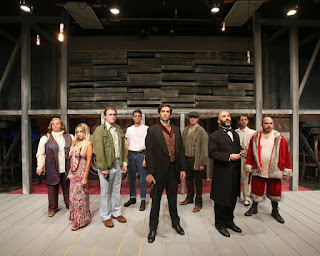Turf Tales
By Tom Wachunas
“…But I actually needed the experience of
wandering, of getting lost, of finding my footing once again in that map, that
place from the past, the place I hope will also be somewhere significant in my
daughter’s legacy.” - Emily Vigil,
on her painting called “Heritage”
EXHIBIT: A Sense of Place – Paintings and Drawings by
Emily Vigil / at Malone Art
Gallery in the Johnson Center at Malone University, THROUGH OCTOBER 8, 2016 /
2600 Cleveland Avenue NW, Canton, Ohio
(A Sense of Place also includes a companion exhibit of
photographs by Mark Pitocco in Malone’s McFadden Gallery.)
Among my more
resonant take-aways from this exhibit by Emily Vigil is a renewed appreciation of a painting as a potent
location unto itself. At its most rudimentary, a painting is a discrete “place”
wherein decisions have been made, where events have transpired – the colors or
lines here, or the shapes and forms there. You could also think of a painting as a
destination, or in a broader sense, the artist’s journey arrested in time. Then,
when we as viewers visit that destination, we in effect continue the journey to
yet another destination, one that is, in the end, of our own determining.
Beyond being just a “picture of something” offered by the artist, a painting is
its own where…a space that can be a
tangible home to the very act of remembering, of association, or of imagining.
Vigil’s expressive,
unfussy brushwork has a plein air spontaneity
about it, and some of her most engaging pieces have been interestingly
engineered so that the picture plane has been divided into picture plains, so
to speak. In these, the overall matrix is composed of smaller nested
rectangles. Imagine observing a landscape from eye-level, from the air, and
zooming in on a smaller component all at the same time. Simultaneous spatial
perspectives.
Additionally, there’s a dual spirit
threaded through this collection. One is of authentic savoring of a remembered,
or fictive (though longed for) place, the other more pressing, as if anxious at
the prospect of lost habitats or environments. The paintings constitute a kind
of mapping of the tentative if not threatened balance between reverential
exploration of a place, and our destructive encroachments upon it.
The large
acrylic, “Heritage,” is an impressive remembrance of Vigil’s 16th-century
ancestors’ home turf in the United Kingdom. Blended into the fern growths and
soil, bathed in a soft, warm light, are snippets of Medieval text and map of
the countryside. In the oil painting, “Coastal Competition,” on the other hand,
we see an aerial view of organized modern streets and structures that feel at
odds with the straight-on, close-up tangle of strangely red branches and
exposed roots at water’s edge, rendered at the top of the image.
Water’s edge
indeed, “Downstream” also gives us an unusual bird’s-eye view of modernity.
This time it’s a double kitchen sink, hovering (or teetering?) above a distant
horizontal seascape. I “read” the sink as the gaping maw of civilized living,
ready to empty its contents into the crashing waves.
And if I’m reading
too much into such images, it’s only because I feel instructed to do so, as in
following a map to a destination. In that sense, I think of Vigil’s paintings
as perceptual cartography.
PHOTOS, from top: Heritage; New River Rhyme; Coastal Competition; Origin; Downstream



















